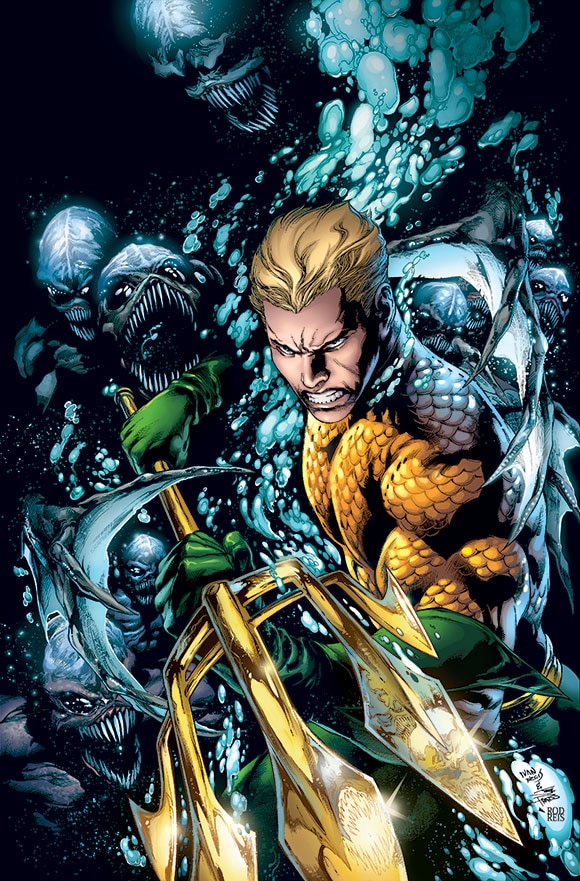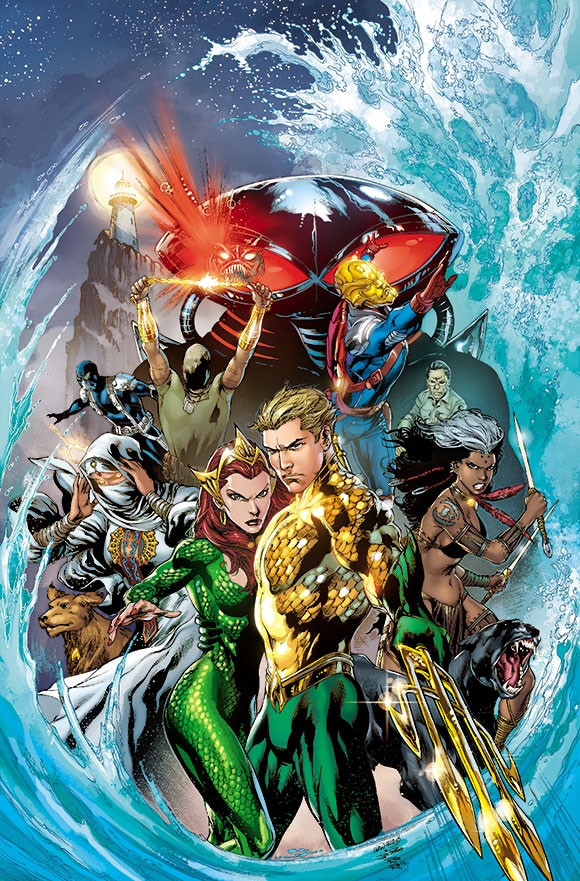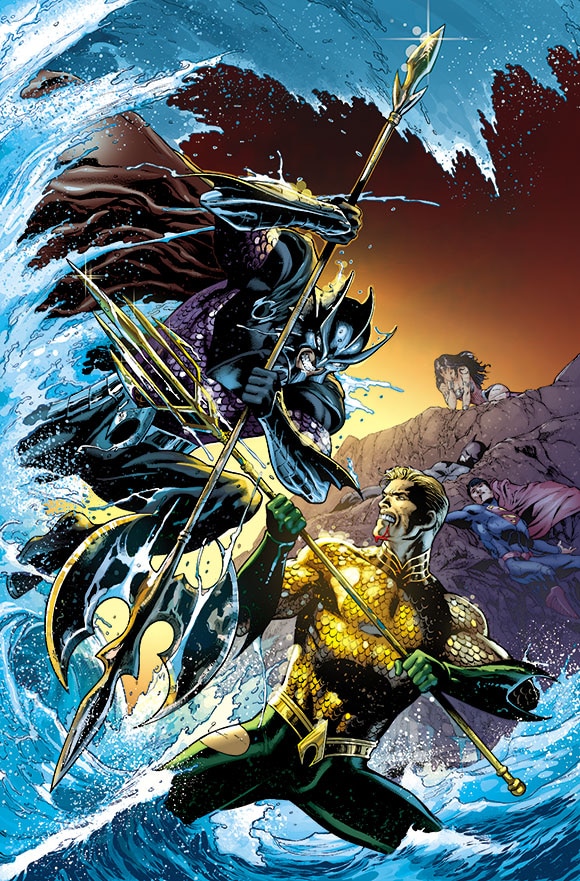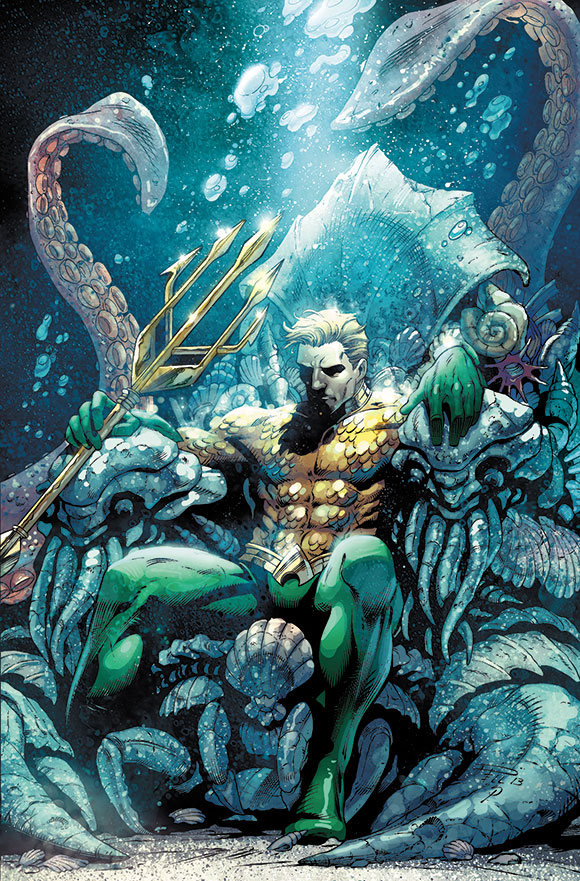What do you think of when you think of Aquaman? What words come to mind? If they’re anything close to “silly,” “inconsequential” or “B-level,” then you haven’t been reading Aquaman’s ongoing comic. At least not since Geoff Johns started writing it.
While Johns may not have the history with the character that he had with Green Lantern, his contribution to Aquaman is no less significant. Of course, to fully understand it, it helps to revisit what Johns has done with Arthur Curry since taking over as writer with Aquaman’s relaunch as part of The New 52.

Aquaman v. 1: The Trench
Drawn by Ivan Reis, who now works with Johns on Justice League, it’s fair to say that 2011’s Aquaman #1 surprised a lot of people. Acknowledging much of the public’s less-than-reverent perception of Aquaman and working that point of view into the initial storyline, Johns presented Arthur as a hero fighting for respect among the community he serves and protects. The result was a fresh, occasionally humorous reintroduction in part because it used the perceived silliness of the character as a part of its foundation.
This is not to say that it turned Aquaman into a joke. Far from it! In fact, the population’s lack of respect for Aquaman as a hero and member of the Justice League leads to some truly poignant moments, many of which play out between Arthur and his love, Mera. Speaking of Mera, she’s established early on as a strong, often fierce woman with layers of complexity, and who doesn’t share Arthur’s affinity for the surface world. In short, a lively companion who will go on to play almost as big a role in the story as Arthur.

Aquaman v. 2: The Others
Of course, if there were any readers who thought Johns might continue down the humorous route the series started with, those thoughts were probably discarded the moment “The Others” hit the comic shops. Exploring Arthur’s past while pushing his relationship with Mera and his role as a hero forward, “The Others” is markedly different than “The Trench.” While Johns seemed to be winking at B-movie horror with his first storyline, the second is pure adventure with a healthy dose of revenge.
Reintroducing popular villain Black Manta and establishing him as a treasure hunter angry at Arthur for killing his father—and this is no mistake, Arthur did kill him when he was younger—this second collection also broadens the setting, finding the storyline leaping from the rainforests of Brazil to the frozen tundra of Siberia to a climax set on an island tomb straight out of something from Indiana Jones. It also introduces an intriguing supporting cast for the series in the Others, a band of adventurers (they’re not exactly heroes) from Arthur’s history that continue to play a role in the series. In short, this is epic scale super hero storytelling at its finest.
Johns accomplishes something else with this volume as well. While the first collection builds Aquaman up as a character, showing readers the emotional depth to be found within Arthur Curry, this storyline builds Aquaman up as a comic series. In the process, Johns demonstrates that not only is Aquaman not a punchline—he’s a complete badass. He’s a bulletproof, powerful fighter who excels in and around water. He’s like a Navy SEAL who prefers fighting hand-to-hand. He’s formidable and deadly (unlike most members of the Justice League, he’s willing to kill when there’s no other choice). And you’ll note, we’re now over a year into the series and Arthur hasn’t used his power over sea life even once.

Aquaman v. 3: Throne of Atlantis
If the first volume was about building Aquaman up as a character and the second about showing the book’s range as a series, this third is all about cementing his importance as a member of the Justice League. A crossover event with the Justice League ongoing (which is also written by Johns), “Throne of Atlantis” broadens the story’s canvas considerably. Johns finally makes use of Arthur’s control over sea life in dramatic fashion and also introduces Atlantis along with many soon-to-be-key characters who reside there. Chief among them is Arthur’s brother Orm, the Ocean Master, a villain of gripping emotional depth and complexity. While Black Manta is single-minded in his hatred for Aquaman and his quest for revenge, Orm is looking out for his people and his dislike and mistrust of the surface world is the result of a lifetime of disrespect at the hands of the “land dwellers.”
As for the story, it’s epic. Atlantis declares war on the surface world, and it’s up to the Justice League to defuse the situation. Arthur’s put in the difficult situation of having to choose between the world he grew up in and the underwater kingdom he’s destined to rule. The story ends with Arthur at last taking his place as the ruler of Atlantis (leading a kingdom that doesn’t exactly trust him). However, it’s also worth calling attention to how this volume begins—a standalone “Zero Issue” story which is absolutely gorgeous.

Death of a King
Johns’ final storyline is still incomplete (at least for one more day!) and not yet compiled into a trade collection. However, it also continues Arthur’s development as a character in The New 52. Here the focus is on his role as the King of Atlantis—a position that’s far from secure. In addition to a faction of the kingdom who wants to see the now imprisoned Orm restored to the throne, there’s also a strange, powerful new king who has laid claim to the throne. And as if that weren’t already enough for a new king to deal with, Johns reintroduces another classic villain here: the ruthless Scavenger.
This is the first Aquaman storyline set almost entirely within Atlantis and as a fantasy epic, it’s downright breathtaking. Packed with splashes and spreads drawn by new series artist Paul Pelletier, the story takes us to an aquatic world full of submersibles, coral-like castles and monstrous undersea behemoths. It also delves into Mera’s past and offers up a brilliant one-two punch of a twist leading into its third act.
Perhaps best of all, however, is the way the story pulls from elements established in the beginning of the series (going all the way back to issue #1!) while also dramatically changing the Aquaman landscape for the future—a future that will now be guided by new series writer Jeff Parker.
If you’re an Aquaman reader, it’s been a fun ride and we’ve been glad to share every moment with you. Like you, we’re both sad to see Johns leave the title and excited to see what Parker has in store for us. However, for those of you who haven’t yet read Johns’ Aquaman, we feel nothing but envy. You have four great volumes of comics you’re yet to discover. Once read, it’s hard to imagine anyone seeing Arthur Curry as any less than a major force in the DC Universe. It’s hard to not want to see Aquaman on film, TV, in his own videogame, and of course, on many, many pages of many, many comic books. In “The Others,” Mera says something to Aquaman that she could just as well be saying to all of us: “Don’t be like the rest of the world, Arthur. Don’t undervalue who Aquaman truly is.”
Thanks to Johns and the rest of the Aquaman team, that’s no longer a problem.





